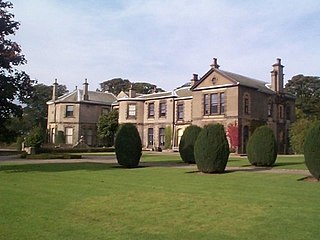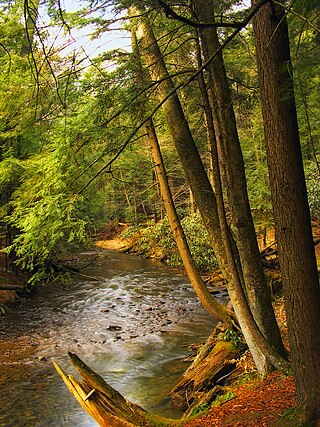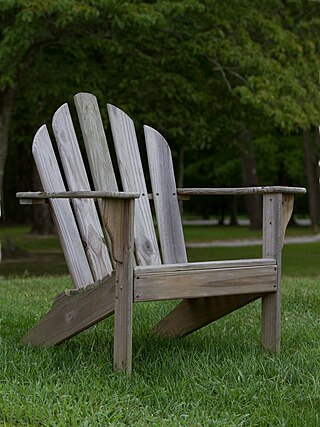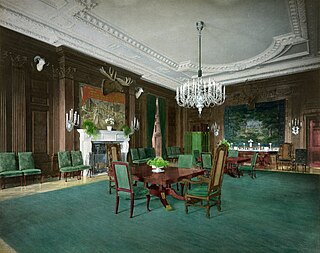Related Research Articles

The Huron–Manistee National Forests are two separate national forests, the Huron National Forest and the Manistee National Forest, combined in 1945 for administration purposes and which comprise 978,906 acres (3,960 km2) of public lands, including 5,786 acres (23 km2) of wetlands, extending across the northern lower peninsula of Michigan. The Huron–Manistee National Forests provide recreation opportunities for visitors, habitat for fish and wildlife, and resources for local industry. The headquarters for the forests is in Cadillac, Michigan.

Lotherton Hall is a country house near Aberford in West Yorkshire, England. It is a short distance from the A1(M) motorway, 200 miles (320 km) equidistant from London and Edinburgh. It is one of nine sites in the Leeds Museums & Galleries group.
Pioneer Village is located inside of the Lagoon Amusement Park in Farmington, Utah. Meant to be a "living museum," Pioneer Village includes artifacts and mementos housed in over two dozen structures, intended to make the history of Utah come alive. It was founded in 1938 near Salt Lake City by Horace and Ethel Sorensen. In April 1975, Lagoon bought the collection from the Sons of Utah Pioneers, and it opened at the amusement park in 1976.

Cook Forest State Park is a 8,500-acre (3,440 ha) Pennsylvania state park in Farmington Township, Clarion County, Barnett Township, Forest County and Barnett Township, Jefferson County, Pennsylvania in the United States. Located just south of the Allegheny National Forest, the park is a heavily wooded area of rolling hills and mountains along the Clarion River in northwestern Pennsylvania. Cook Forest State Park is known for some of America's finest virgin white pine and hemlock timber stands and was once called the "Black Forest" due to the preponderance of evergreen tree coverage.

The State Dining Room is the larger of two dining rooms on the State Floor of the Executive Residence of the White House, the home of the president of the United States in Washington, D.C. It is used for receptions, luncheons, larger formal dinners, and state dinners for visiting heads of state on state visits. The room seats 140 and measures approximately 48 by 36 feet.
The Kittinger Company is an American maker of traditional colonial reproduction furniture that was founded in 1866. Today Kittinger is known for the high-quality furniture it produces that is featured prominently in the White House.

The President's Dining Room is a dining room located in the northwest corner of the second floor of the White House. It is located directly above the Family Dining Room on the State Floor and looks out upon the North Lawn. The Dining Room is adjacent to the Family Kitchen, a small kitchen designed for use by the First Family, and served by a dumbwaiter connected to the main kitchen on the ground floor.
Katie Walker is a British furniture designer well known for combining simple components in her work. Her designs combine the function of the object with a sculptural interpretation of its structure. She works with craft and volume manufacturers and produces specific one-off commissions from a variety of materials.

The Old Faithful Historic District in Yellowstone National Park comprises the built-up portion of the Upper Geyser Basin surrounding the Old Faithful Inn and Old Faithful Geyser. It includes the Old Faithful Inn, designed by Robert Reamer and is itself a National Historic Landmark, the upper and lower Hamilton's Stores, the Old Faithful Lodge, designed by Gilbert Stanley Underwood, the Old Faithful Snow Lodge, and a variety of supporting buildings. The Old Faithful Historic District itself lies on the 140-mile Grand Loop Road Historic District.

Rustic furniture is furniture employing sticks, twigs or logs for a natural look. The term “rustic” is derived from Latin “rusticus”. The style is rooted in Romantic tradition. In the US it is almost synonymous with the National Park Service rustic style of architecture. Many companies, artists and craftspeople make rustic furniture in a variety of styles and with a variety of historical and contemporary influences.

Log furniture is a type of rustic furniture made by incorporating the use of whole logs. It is often designed to have a "pioneer" look. Log furniture is often very durable and long-lasting, depending on the manufacturing methods used.
Matthew Burt is a British furniture designer-maker who runs a contemporary practice from a studio and workshop based in the South Wiltshire village of Sherrington, west of Salisbury. His work has been displayed in significant public exhibitions, most notably in the OneTree touring show and at the House of Commons in 2008 in a selection of work intended to raise the profile of UK furniture making. Burt's workshop steadily built on a reputation for furniture design that allies structurally robust work that fulfils its function with a lean, elegant line and the occasional bravura surface. Burt has said that he regards the 'intermingling of science, engineering, mathematics, aesthetics and metaphorics' as the building blocks for his furniture.

A. H. Davenport and Company was a late 19th-century, early 20th-century American furniture manufacturer, cabinetmaker, and interior decoration firm. Based in Cambridge, Massachusetts, it sold luxury items at its showrooms in Boston and New York City, and produced furniture and interiors for many notable buildings, including The White House. The word "davenport," meaning a boxy sofa or sleeper-sofa, comes from the company.

Furniture created in the Art Nouveau style was prominent from the beginning of the 1890s to the beginning of the First World War in 1914. It characteristically used forms based on nature, such as vines, flowers and water lilies, and featured curving and undulating lines, sometimes known as the whiplash line, both in the form and the decoration. Other common characteristics were asymmetry and polychromy, achieved by inlaying different colored woods.

Jalisco handcrafts and folk art are noted among Mexican handcraft traditions. The state is one of the main producers of handcrafts, which are noted for quality. The main handcraft tradition is ceramics, which has produced a number of known ceramicists, including Jorge Wilmot, who introduced high fire work into the state. In addition to ceramics, the state also makes blown glass, textiles, wood furniture including the equipal chair, baskets, metal items, piteado and Huichol art.
The Acadia Plantation was a historic plantation house in Thibodaux, Louisiana, U.S.. It was the plantation of James Bowie, Rezin P. Bowie, and Stephen Bowie. James "Jim" Bowie, served in the Battle of the Alamo. It was listed on the National Register of Historic Places on May 29, 1987. It was demolished in 2010.
Max Lamb is a British furniture designer who combines traditional, often primitive, design methods with digital design. He is known for employing unusual approaches to using natural materials, including pouring pewter onto sand, and volcanic rock.
Wendy Maruyama is an artist, furniture maker, and educator from California. She was born in La Junta, Colorado.
The Gallia family Hoffman apartment collection is a set of furniture and decorative objects that are the surviving Vienna Secession style contents of the 1913 apartment of wealthy businessman Moritz Gallia and his wife and Hermine, mostly designed by leading architect and designer Josef Hoffman. When the Gallia's children had to flee the Anschluss with Nazi Germany in 1938, they brought what remained with them to Australia, a place 'as far away as they could get', where it was subsequently purchased in 1976 by National Gallery of Victoria, and pieces have been on permanent display since 1984.
Killarney Mountain Lodge is a resort located on Georgian Bay in Killarney, Ontario. Killarney Mountain Lodge contains the Canada House Conference Centre, the largest log-built conference centre in the world. The name "Canada House" comes from the local techniques, where people and materials were brought together in the completion of this structure. Construction started in 2017 and the building was finished in 2019.
References
Updated through : Records for the shrine dating back to 1944 as well as the historical society for the local area and the caretakers of the shrine currently as well as past.